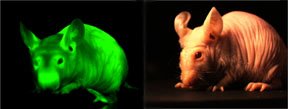 I have found that much of what is weird in our world is in no small part caused or created by humans, that is, we are just plain weird by nature. For example, we genetically modified animals to suit our own purposes and now they are a huge part of medical research. This has led us one step closer to seeing green Eggs and Ham on the menu of your favorite restaurant. Let’s take a closer look…
I have found that much of what is weird in our world is in no small part caused or created by humans, that is, we are just plain weird by nature. For example, we genetically modified animals to suit our own purposes and now they are a huge part of medical research. This has led us one step closer to seeing green Eggs and Ham on the menu of your favorite restaurant. Let’s take a closer look… Since the 1980s, it has been possible to insert non-native genes (transgenic) from mice. Mice are used for a few reasons; they're small and don't eat much, so you can house them fairly inexpensively and they breed quickly so you can have a fairly steady stream of animals.
Since the 1980s, it has been possible to insert non-native genes (transgenic) from mice. Mice are used for a few reasons; they're small and don't eat much, so you can house them fairly inexpensively and they breed quickly so you can have a fairly steady stream of animals.
The benefits for using transgenic mice are enormous, both in medical research for humans and animals. Through the use of transgenic mice a scientist can isolate a particular disease or condition for further study or they can be used to clarify the role of a particular protein in a disease. This can be useful amongst other cases when you have an inhibitor to an enzyme that is fairly dirty, making it difficult to tease out exactly what pathway is responsible for the effect you are looking for. By comparing the results to the same model in transgenic mice, it is possible to confirm that the effect you see is due to inhibition of that pathway.
One transgenic mouse that is often crossed onto other lines is the eGFP mouse. This little critter has been modified to express a modified jellyfish protein, enhanced Green Fluorescent Protein (eGFP) which means that this sucker is fluorescent green in color and glows in the dark!! The eGFP is constitutively expressed in all the cells of these mice, although not the fur. While this might not sound like much use, it comes in very handy in studies that involve transplantation of tissues between animals. If the donor cells come from an eGFP mouse, it is child's play to identify them. All you need is a fluorescent microscope. And yes, when you look at the insides of an eGFP mouse, they do have a green tinge.
Critics of using mice in research will often point out that as research animals go, mice aren't really that close to humans, and that higher mammals such as pigs or primates are better. To that end, a laboratory in Taiwan has announced the creation of GFP pigs that express the protein in all their cells, even their internal cells are fluoro-green and glow! "There are partially fluorescent green pigs elsewhere, but ours are the only ones in the world that are green from inside out. Even their hearts and internal organs are green," Wu said today. This means that the entire pig, both inside and out glows in the dark!!! “The transgenic pigs, commonly used to study human diseases, would help researchers monitor and trace changes of the tissues during the physical development,” said Wu Shinn-Chih of the university's Institute and Department of Animal Science and Technology.
“The transgenic pigs, commonly used to study human diseases, would help researchers monitor and trace changes of the tissues during the physical development,” said Wu Shinn-Chih of the university's Institute and Department of Animal Science and Technology.
In 2003, a Taiwan company began selling the world's first genetically engineered fish, sparking protests by environmentalists who said the fluorescent green fish posed a threat to the earth's ecosystem. Although I am not quite sure how.
Now that we can make glow in the dark animals I do not doubt that some resourceful entrepreneur will find ways to bring these animals to the open market. How about a habitrail of glow in the dark gerbils in your kids room; no more need for a night lite! Another, use for eGFP mice that express a red fluorescent protein, could also be for use as Christmas tree decoration; why have ropes of blinking lights when you could ring your tree with clear tubes and have red and green critters running around the tree - I know these glowing little suckers would keep your cat entertained for hours!
Although green bacon won't be making its way onto the shelves any time soon, I bet it won’t be long!!!
I’m Average Joe
Saturday, January 14, 2006
Green Eggs and Ham on Every Breakfast Table?
Subscribe to:
Post Comments (Atom)


No comments:
Post a Comment